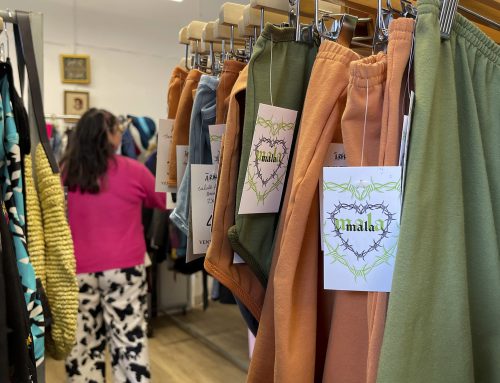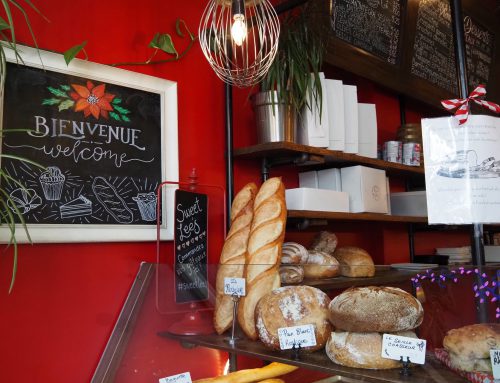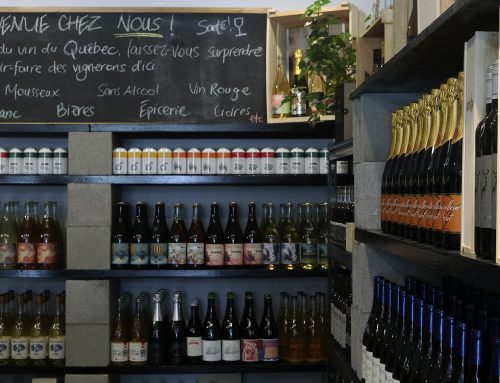BY Linnaea Davis & Jamie-Anne Gilbert
“I find shopping in person a bit stressful,” admits Jennifer Johnston, a 25-year-old Montrealer who relocated from Ottawa a few years ago and now resides in Villeray.
She enjoys frequenting local coffee shops and leisurely strolls, but finds the hustle and bustle of downtown Montreal overwhelming, with its crowded stores and packed public transport. Johnston explains she much prefers the convenience of shopping from the comfort of her own home.
“I can’t always find my size in-store, fitting rooms tend to have a long line, and not all of the products that you see online end up being available in-store,” she says.
Johnston is among many Canadians who has come to prefer shopping online compared to in person, saying she finds it more relaxing, convenient and less time-consuming.

Jennifer Johnston, 25, is among the growing number of Canadians who favour online shopping over traditional in-store retail. Photo by Linnaea Davis.
According to Statistics Canada, in 2020, 82 per cent of Canadians turned to online shopping when numerous stores were forced to close due to the COVID-19 pandemic. That’s helped make spending time online more prevalent than ever before. Consequently, business models are rapidly evolving to adapt to these new consumer trends.
While the surge in online shopping has tapered off since 2020, numbers remain higher than before. Statista predicts a steady rise in the coming years, with projections indicating 86 per cent of Canadians opting for at least some online shopping by 2026.
Leyssa Clergeau, 23, says she appreciates the efficiency of online shopping, allowing her to save time amidst her busy schedule.
“Online, stores are accessible 24/7,” she says. “I have access to a wider variety of products online, I can easily compare prices and read product reviews, […] and I often find better discounts online,” she says.
Many online store platforms offer limited-time offers or frequent promotions for members of the given store.
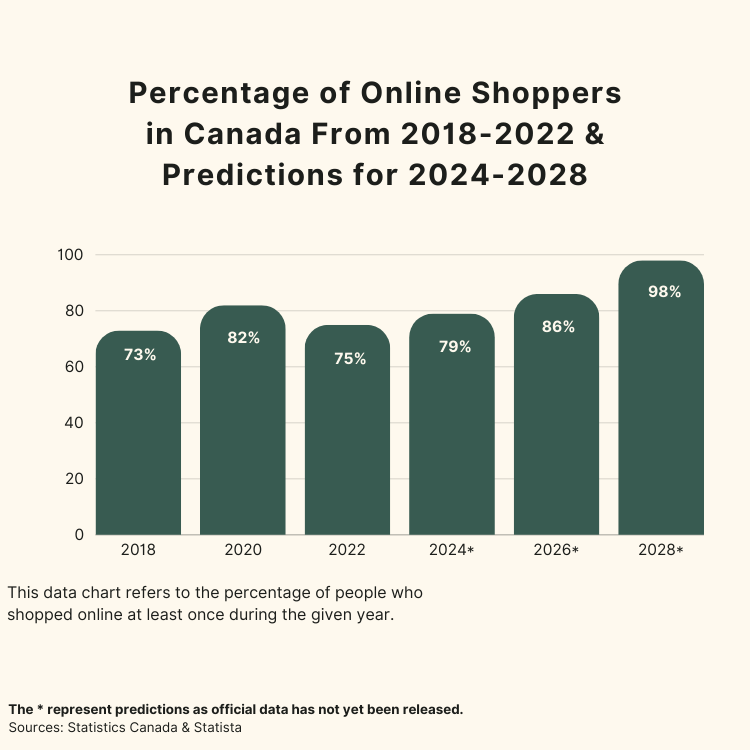
This infographic illustrates the annual percentage of online shoppers, more specifically people who have shopped online at least once, between 2018 and 2022, with projected trends extending to 2024-2028. Media by Linnaea Davis.
Benjamin Rousse, Policy Analyst for the Canadian Federation of Independent Businesses (CFIB), highlights that numerous independent businesses have adapted their marketing strategies in recent years, particularly in response to the shifting consumer trends and behaviour spurred by the COVID-19 pandemic.
Through surveys conducted with its members, the CFIB can analyze the needs and trends of independent businesses, enabling them to better respond to such demands.
“There’s a strong desire among businesses, especially in sectors like the arts, recreation, beauty, and retail, to establish an online presence,” Rousse notes.
However, Rousse emphasizes the continued importance of in-store shopping, especially considering the nature of certain products or services.
“Some businesses distinguish themselves from their competitors by offering in-person services, providing their customers with a level of attention and expertise that cannot be replicated online, and which large corporations cannot match,” he says, providing the example of purchasing running shoes in-store. Customers benefit from personalized service, expert advice, and the chance to try on shoes, an experience that online shopping may not provide.
Online shopping is blooming, so why are cities pouring money into malls? Video by Jamie-Anne Gilbert.
Keisha Lourdes, founder of Nuances Self-Care, a Montreal-based haircare and skincare brand, underscores the significance of her business’ online presence since its debut in 2020.
“During [the pandemic], many stores deemed non-essential were closed or had reduced hours allowing us to fill the void that consumers had,” she states.
Online giants dominate the market, making it challenging for small businesses to compete, particularly in terms of pricing and delivery speed.
But as Lourdes says, “If we can’t beat them, we join them.”
Many small businesses like Nuances Self-Care have joined the online marketplaces like that of Amazon or Walmart to sell and promote their products.
Rousse acknowledges that many CFIB members express difficulties in competing with online giants due to their dominance over these marketplaces, where they dictate policies and regulations.
Despite these challenges, however, Rousse says that entering the online market can significantly benefit businesses’ growth. Many have adapted their business models to thrive through online advertising and shopping, leading to increased sales and success in the past year.
Santo Romano, a professor of Design and Computational Arts at Concordia University, underscores the growing demand for enhanced design in response to the increased reliance on online platforms.
“If there was a mantra of UX design it would be, ‘don’t make me think,’” he says.
User Experience (UX) design revolves around creating digital experiences that are intuitive and enjoyable for users. The field involves studying user needs and behaviours to create interfaces that are efficient and aligned with current trends and preferences.
“Ease of use has become a key element in marketing for businesses,” says Romano, highlighting that the field of UX design is a branch of design dedicated to this ‘ease of use’ marketing strategy.
With the rise of online shopping reshaping how businesses market themselves, they are increasingly prioritizing their online presence, utilizing social media and digital marketing to connect with their target audience, and allocating resources to enhance the user experience of online shopping.
Romano explains that with the significant evolution of web development in the past decade, a particular focus is placed on analyzing and responding to how design influences user patterns and behaviours today.
“We don’t overwhelm someone with too much information, we make it simple enough for them to be able to use and find what they are looking for.” Design and UX principles often employ things like calls to action as a way of taking users by the hand and guiding them to make a certain choice.
The success of these techniques is confirmed by Johnston who describes her online shopping experience as “much easier and more relaxing.”
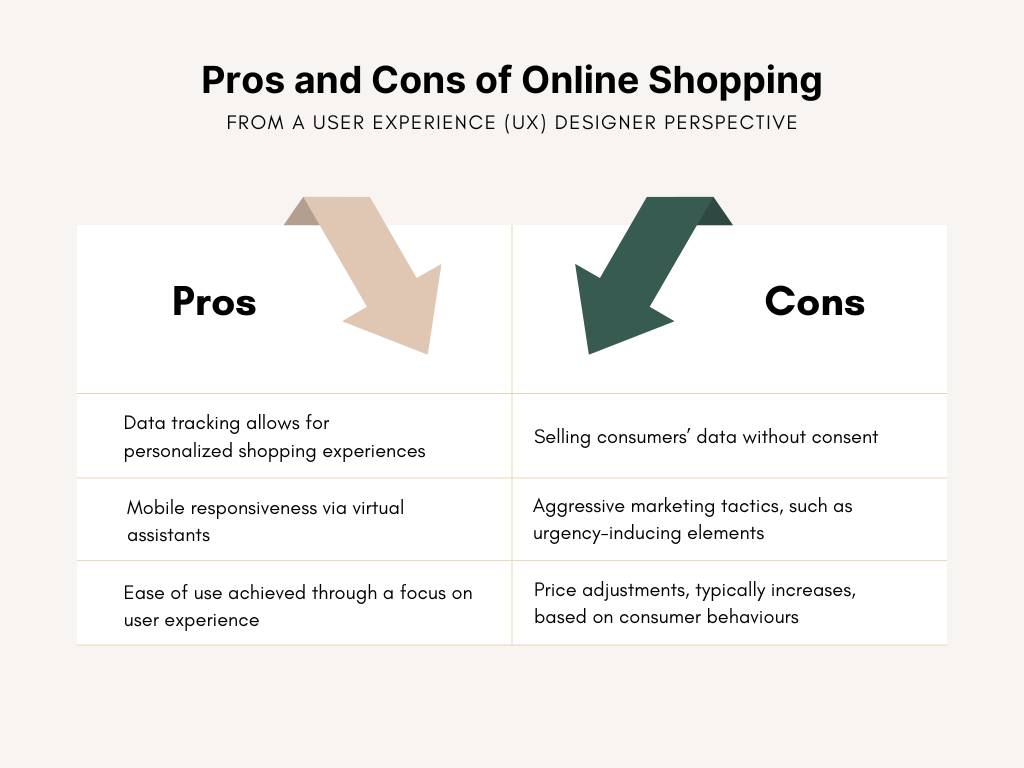
Santo Romano, UX Designer and Web Developer, lists some pros and cons of online shopping. Media by Linnaea Davis.
While acknowledging that she overspent on marketing agencies when she first launched her business, Lourdes now says she prefers conducting her business online as it allows her to have more time to invest in making her products, marketing strategies and doing other activities related to or outside of work.
“With in-store shopping, in my case popups, I have to be present during the selling process for 8 hours a day which can be time consuming and draining,” she states. Although she does enjoy meeting and connecting with customers in person and witnessing their reactions to her products firsthand rather than solely through online reviews.
Jimmy Zoubris, advisor to Montreal Mayor Valerie Laplante, emphasizes the City’s commitment to fostering community engagement and neighbourhood vibrancy through in-person shopping.
“Our approach has evolved significantly since the COVID-19 pandemic,” Zoubris elaborates, highlighting changes in shopping patterns and how people perceive Montreal. “Since Valérie Laplante took power, our strategy has been very community oriented.”
He explains that shopping extends beyond the store itself; it’s also about the surrounding experience and that’s what keeps people in a given neighbourhood.
“You may go to store A to buy some clothes, but then you step over to the coffee shop next door for a great coffee, and then you’ll have a bagel bakery beside the coffee shop,” he says. “It’s all about the experience surrounding the shopping that becomes important.”
“I would definitely make use of public spaces if more were available,” says Johnston, who admires the vibrancy of Montreal during the summer, with streets like Mont-Royal and St-Laurent closed off for festivals, street vendors, and terraces.
However, she clarifies that her desire to stroll down a pedestrian street and enjoy green spaces isn’t primarily for shopping. Rather, it’s to spend time with friends, grab a coffee, and perhaps browse a few stores if something catches her eye. For dedicated shopping, she still prefers the ease and convenience of online platforms.

